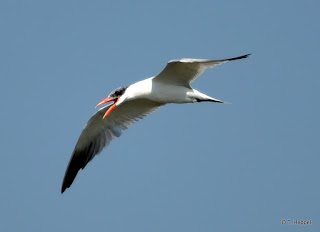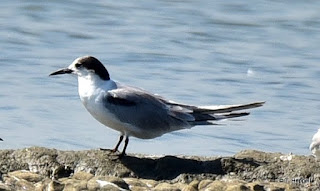Laem Pak Bia wetlands and Pak Thale salt pans in Petchaburi are 2 sites well-known for waders and shorebirds and during Thailand’s dry “winter” months October to March when the birds migrate
On Sunday 22, Uthai from Chiangmaibirding picked our group of 4 from Don Meung airport. The Air Asia flight arrived at noon and after a quick stop at one of the highway cafes, we arrived Laem Pak Bia at 3.30pm. We saw 2 Black-winged Kites and many Red-turtle doves on the wires along the country roads.
The waders were feeding in flocks but quite far out and we spotted another vehicle near a shed. It was not easy trying to scope the "Spoonie" among the waders. We saw lots of Plovers, Gulls, Sandpipers and Terns. The driver of the vehicle passed us on his way out and mentioned he had seen 1 Spoonbill Sandpiper among the flocks. We scrutinised the flocks with the scope but the sunlight was waning so we decided to leave and return the next morning for a longer stay. On Monday 23, after breakfast, we left at 7.30 am to the Laem Pak Bia King’s Project near us and drove along the bunds of the ponds. There were mainly Javan Pond herons, Black-winged Stilts and Egrets feeding with Little Commorants perched on sticks and structures in the ponds.
We took a short walk on the mangrove boardwalk and a couple of Pied Fantails and Yellow-bellied Gerygones were singing but hard to see in the thick foliage. We then drove to Pak Thale and stayed till lunch time. We moved quite close to the sea but each time we come close, the flocks would fly to another spot. It was difficult spotting the tiny Spoon-billed Sandpiper. We left at noon to escape the hot sun. There was time to kill after lunch so it was a relaxing spa treatment at the i Tara. At 4pm we went back to Pak Thale but could not locate the star bird.
 |
| Entrance road to Pak Thale |
from the northern winter the critically endangered Spoon-billed Sandpiper has been reported to be seen at Pak Thale. Both sites are within 3 hours’ drive from Bangkok airport and we included them on this trip to Kaeng Krachan. We booked the i Tara Resort & Spa, a seaside resort on the northern sandy beach of Petchaburi for 2 nights. Nearby were some salt pans but generally the area is a village with a few shops and a couple of small establishments for dinning out, a peaceful place to stay for sun and sea without the crowds.
 |
| Black-winged Kite |
On Sunday 22, Uthai from Chiangmaibirding picked our group of 4 from Don Meung airport. The Air Asia flight arrived at noon and after a quick stop at one of the highway cafes, we arrived Laem Pak Bia at 3.30pm. We saw 2 Black-winged Kites and many Red-turtle doves on the wires along the country roads.
After checking into the i Tara Resort, we went to Pak Thale salt pans for a quick look before the sunset.
 |
| Caspian Tern |
 |
| Common Tern |
On Tuesday 24 we went to Laem Pak Bia King’s Project and this time we walked the full boardwalk
to the sea end and it was a spectacular view of the mangrove forest as we looked back. As we had booked a visit to Lung Sin's hide at Kaeng Krachan in the afternoon, we left Laem Pak Bia around 10.30 am for the 2-hour drive.
We checked into Baan Song Nok around noon and had lunch at a nearby "restaurant" watching an Indian Roller who was hiding from the hot sun.
On Wed 25, we left at 6 am to Paneongtung summit which was 1.5 hours drive from the Park entrance.
Many visitors had camped overnight at the top to catch the sunrise over the white fluffy clouds. There was a fruiting tree across the valley near the campsite and barbets, bulbuls and flycatchers were busy feeding in the early morning. After our breakfast we drove up to another viewpoint looking for the dried bamboo flowers that the Pin-tailed Parrotbills feed on. At 10 am a bird wave brought the parrot-bills but it was difficult to photograph these small birds so we waited for another round of feeding. Near lunch time we drove down to Bang Krang campsite, while walking around the campsite we saw a pair of Violet Cuckoos feeding in the trees. On the way down we stopped by a couple of fig trees with birds feeding but the foliage was thick and hard to photograph the birds. We went back to Ban Song Nok and birded at the hide till dinner time.
 |
| Chestnut-headed Bee-eater |
Thursday 26 we left at 6.30 am for the Park and stopped on the road near the big fig tree at km 8 to stake out the Black-thighed Falconets that had been regularly seen. It was still misty when 3 Falconets came but they flew off too quickly. We waited for their return but they did not show after
an hour or so, meanwhile we heard the knocking of wood and found a Heart-spotted Woodpecker building a nest hole. She was then relieved by the male after some time. The male extracted the chippings from the hole and continued with his pecking work. We spent some time watching this pair then drove on to Bang Krang for lunch. We left after a short stay and drove out of the Park to the coffee place opposite Sarman's Bird Camp and while having coffee we had good views of the Thick-billed Flowerpeckers feeding on the Indian Cherry trees. Towards the late afternoon it was back to Auntie Aek's hide and it was the usual suspects that came to bathe at the 2 pools.
 |
| Green Magpie |
We left Friday 27 after breakfast and it was a longer drive back to Don Meung due to heavy traffic.
 |
| Black-naped Monarch |
 |
| Racket-tailed Treepie |
 |
| Bar-backed Partridge |
 |
| Large Scimitar Babbler |
Birds Seen at Laem Pak Bia and Pak Thale:
| 1 |
Black-winged Kite
| 18 |
White-throated Kingfisher
| |
| 2 |
Red-wattled Lapwing
| 19 |
Common Kingfisher
| |
| 3 |
Asian Openbill Stork
| 20 |
Black-capped Kingfisher
| |
| 4 |
Grey-headed Lapwing
| 21 |
Intermediate Egret
| |
| 5 |
Asian Pied Starling
| 22 |
Little Egret
| |
| 6 |
Red Turtle Dove
| 23 |
Chinese Egret
| |
| 7 |
Blue-tailed Bee-eater
| 24 |
Great Egret
| |
| 8 |
Crested Myna
| 25 |
Little Cormorant
| |
| 9 |
Curlew Sandpiper
| 26 |
Grey Heron
| |
| 10 |
Kentish Plover
| 27 |
Brown-headed Gull
| |
| 11 |
Black-winged Stilt
| 28 |
Common Tern
| |
| 12 |
Streak-eared Bulbul
| 29 |
Caspian Tern
| |
| 13 |
Javan Pond Heron
| 30 |
Heuglin's Gull
| |
| 14 |
Yellow-eyed Babbler
| 31 |
Painted Stork
| |
| 15 |
Whiskered Tern
| 32 |
House Sparrow
| |
| 16 |
Common Sandpiper
| 33 |
Brahminy Kite
| |
| 17 |
Wood Sandpiper
| 34 |
Pied Fantail
| |
Birds Seen at Kaeng Krachan:
| 1 |
Oriental Magpie Robin
| 27 |
Blue-throated Barbet
| |
| 2 |
Indian Roller
| 28 |
Great Barbet
| |
| 3 |
Chestnut-headed Bee-eater
| 29 |
Golden-throated Barbet
| |
| 4 |
Grey-cheeked Fulvetta
| 30 |
Pin-tailed Parrotfinch
| |
| 5 |
White-rumped Shama
| 31 |
Hainan Blue Flycatcher
| |
| 6 |
Black-naped Monarch
| 32 |
Ashy Drongo
| |
| 7 |
Verditer Flycatcher
| 33 |
Crow-billed Drongo
| |
| 8 |
Striped-throated Bulbul
| 34 |
Black-headed Bulbul
| |
| 9 |
Flavescent Bulbul
| 35 |
Black-crested Bulbul
| |
| 10 |
Racket-tailed Treepie
| 36 |
Sooty-headed Bulbul
| |
| 11 |
Pin-striped Tit Babbler
| 37 |
Taiga Flycatcher
| |
| 12 |
Scaly-breasted Partridge
| 38 |
Siberian Blue Robin
| |
| 13 |
Bar-backed Partridge
| 39 |
Abbot's Babbler
| |
| 14 |
Puff-throated Babbler
| 40 |
Arctic Warbler
| |
| 15 |
Red Jungle Fowl
| 41 |
Vernal Hanging Parrot
| |
| 16 |
Greater-necklaced Laughing Thrush
| 42 |
Blue-bearded Bee-eater
| |
| 17 |
Green Magpie
| 43 |
Common Flameback
| |
| 18 |
Tickell's Blue Flycatcher
| 44 |
Greater Flameback
| |
| 19 |
Large Scimitar Babbler
| 45 |
Heart-spotted Kingfisher
| |
| 20 |
White-browed Scimitar Babbler
| 46 |
Violet Cuckoo
| |
| 21 |
Emerald Dove
| 47 |
Oriental Pied Hornbill
| |
| 22 |
Kalij Pheasant
| 48 |
Thick-billed Flowerpecker
| |
| 23 |
Red Legged Crake
| 49 |
Brown-throated Sunbird
| |
| 24 |
Slaty-legged Crake
| 50 |
Coppersmith Barbet
| |
| 25 |
Grey-eyed Bulbul
| 51 |
Lineated Barbet
| |
| 26 |
Mountain Bulbul
| 52 |
Black-thighed Falconet
| |


No comments:
Post a Comment